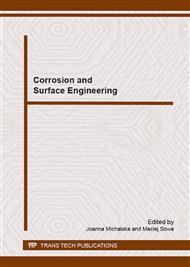p.3
p.7
p.11
p.15
p.19
p.23
p.27
p.31
Novel Concepts on the Growth of Corrosion Fatigue Small and Short Cracks
Abstract:
Corrosion fatigue small, short and long crack growth rates have been determined for a 12Cr steam turbine steel in aerated 300 ppb Cl- + 300 ppb SO42- solution and in air at 90 °C. The crack growth rate for short and long cracks was monitored by direct current potential drop (DCPD) and for the small cracks by combining high resolution optical microscopy and DCPD. Comparison of the fatigue growth rate demonstrated that in solution the short crack growth rate was remarkably enhanced in comparison to long cracks, when the crack size is smaller than 250 μm. This enhancement was attributed to the electrochemical crack size effect associated with greater anodic polarisation of the short crack in such low conductivity solution. However, such enhanced growth was not observed for small cracks, which was rationalised on the basis of additional contribution of current from the pit limiting crack-tip polarisation.
Info:
Periodical:
Pages:
3-6
Citation:
Online since:
January 2015
Authors:
Keywords:
Price:
Сopyright:
© 2015 Trans Tech Publications Ltd. All Rights Reserved
Share:
Citation:


